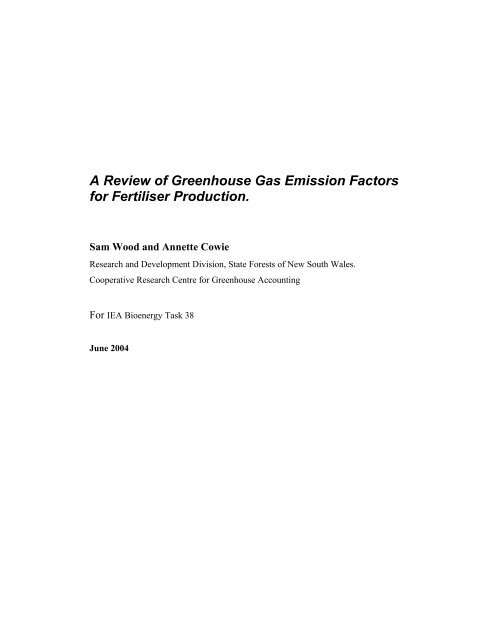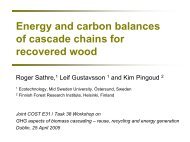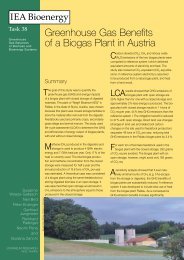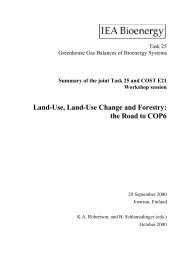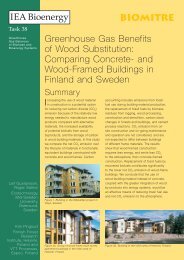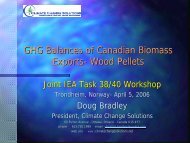A review of greenhouse gas emission factors for fertiliser production.
A review of greenhouse gas emission factors for fertiliser production.
A review of greenhouse gas emission factors for fertiliser production.
You also want an ePaper? Increase the reach of your titles
YUMPU automatically turns print PDFs into web optimized ePapers that Google loves.
A Review <strong>of</strong> Greenhouse Gas Emission Factors<strong>for</strong> Fertiliser Production.Sam Wood and Annette CowieResearch and Development Division, State Forests <strong>of</strong> New South Wales.Cooperative Research Centre <strong>for</strong> Greenhouse AccountingFor IEA Bioenergy Task 38June 2004
1. IntroductionGiven their significant contribution to rising atmospheric <strong>greenhouse</strong> <strong>gas</strong>concentrations, accounting <strong>for</strong> <strong>emission</strong>s <strong>of</strong> CO 2 , N 2 O and CH 4 from agriculturalpractices has become increasingly important. Emissions <strong>of</strong> these <strong>gas</strong>es may occureither directly during agricultural activities (eg. cultivation and harvesting), orindirectly during the <strong>production</strong> and transport <strong>of</strong> required inputs (eg. herbicides,pesticides and <strong>fertiliser</strong>s). Life Cycle Assessment (LCA) is commonly employed toundertake a complete evaluation <strong>of</strong> <strong>emission</strong>s. In LCA the environmental impacts <strong>of</strong>products and processes are analysed from ‘cradle to grave’, such that both direct andindirect <strong>emission</strong>s from agricultural practices are included.The <strong>production</strong> <strong>of</strong> <strong>fertiliser</strong>s demands much energy and generates considerable<strong>greenhouse</strong> <strong>gas</strong> (GHG) <strong>emission</strong>s. Kongshaug (1998) estimates that <strong>fertiliser</strong><strong>production</strong> consumes approximately 1.2% <strong>of</strong> the world’s energy and is responsible <strong>for</strong>approximately 1.2% <strong>of</strong> the total GHG <strong>emission</strong>s. As such, <strong>fertiliser</strong> <strong>production</strong>comprises an important component <strong>of</strong> agricultural Life Cycle Assessments wheresystem boundaries are wide enough to include indirect <strong>emission</strong>s from agriculturalinputs. Directly calculating GHG <strong>emission</strong>s from <strong>fertiliser</strong> <strong>production</strong> <strong>for</strong> individualLCA studies is problematic given the large variety <strong>of</strong> <strong>fertiliser</strong>s used and the complexprocesses involved in their <strong>production</strong>. Furthermore, the <strong>emission</strong>s data required <strong>for</strong>such calculations are either difficult to obtain or constrained in their extent and quality(Patyk 1996).Emission <strong>factors</strong> provide a useful shortcut <strong>for</strong> use in LCA, avoiding the need <strong>for</strong>detailed calculations <strong>of</strong> <strong>emission</strong>s. An <strong>emission</strong> factor is a typical quantity <strong>of</strong> GHGsreleased to the atmosphere per unit <strong>of</strong> activity, in this case, per unit weight <strong>of</strong> <strong>fertiliser</strong>produced (i.e. g CO 2-e / kg <strong>fertiliser</strong>). Since <strong>fertiliser</strong> <strong>emission</strong> <strong>factors</strong> vary widelydepending on <strong>production</strong> technology, it is preferable to use customised <strong>emission</strong><strong>factors</strong> relevant to the particular plant from which the <strong>fertiliser</strong> under considerationwas produced. Un<strong>for</strong>tunately, such in<strong>for</strong>mation is rarely available. The objective <strong>of</strong>this report is to collate published <strong>emission</strong> <strong>factors</strong> <strong>for</strong> GHGs associated with the<strong>production</strong> <strong>of</strong> a range <strong>of</strong> nitrogen, phosphate and multi-nutrient <strong>fertiliser</strong>s, <strong>for</strong> use as2
inputs to agricultural and <strong>for</strong>estry Life Cycle Assessments and calculations <strong>of</strong><strong>greenhouse</strong> <strong>gas</strong> balance.1.1. Scope.During the life cycle <strong>of</strong> <strong>fertiliser</strong> products, GHG <strong>emission</strong>s may arise during theextraction <strong>of</strong> resources, the transport <strong>of</strong> raw materials and products, and during<strong>fertiliser</strong> <strong>production</strong> processes. Where possible, separate <strong>emission</strong>s <strong>factors</strong> areprovided <strong>for</strong> each step in this life cycle. Emissions arising from the application <strong>of</strong><strong>fertiliser</strong>s in the field were not considered. A brief discussion <strong>of</strong> key processesinvolved in the <strong>production</strong> <strong>of</strong> each type <strong>of</strong> <strong>fertiliser</strong>, and their associated <strong>emission</strong>s, isincluded in this report.Emissions <strong>factors</strong> <strong>for</strong> similar <strong>fertiliser</strong> products differ markedly between reports,depending on certain aspects <strong>of</strong> plant design and efficiency, <strong>emission</strong>s controlmechanisms and raw material inputs. The assumptions made by the analysts duringthe calculations <strong>of</strong> <strong>emission</strong> <strong>factors</strong> also contribute to this variation. Ideally, detailedin<strong>for</strong>mation regarding the cause <strong>of</strong> between-source variation would be provided hereto guide the selection <strong>of</strong> the appropriate <strong>emission</strong> factor <strong>for</strong> particular LCA’s.However, the extent to which this type <strong>of</strong> in<strong>for</strong>mation was documented in the<strong>review</strong>ed studies was <strong>of</strong>ten limited (see ‘Transparency’ in Table 1). As a result <strong>of</strong> thislack <strong>of</strong> transparency, comparisons <strong>of</strong> <strong>emission</strong> <strong>factors</strong> were considered beyond thescope <strong>of</strong> this <strong>review</strong>, and only limited discussions <strong>of</strong> between-source variability couldbe provided.GHG <strong>emission</strong>s from <strong>fertiliser</strong> <strong>production</strong> are closely associated with energyconsumption. Most studies <strong>review</strong>ed here coupled <strong>emission</strong>s estimates with detailedenergy budgets (see Table 1). Data on energy consumption during <strong>fertiliser</strong>manufacture are not presented here, but discussion <strong>of</strong> the relationship between<strong>emission</strong>s <strong>factors</strong> and energy consumption are included in the text.3
1.2. UnitsThe significant GHG <strong>emission</strong>s arising from the <strong>production</strong> <strong>of</strong> <strong>fertiliser</strong>s are carbondioxide (CO 2 ), nitrous oxide (N 2 O) and methane (CH 4 ). In line with international<strong>greenhouse</strong> accounting practice (IPCC 1996a), <strong>emission</strong> <strong>factors</strong> are expressed ascarbon dioxide equivalents per unit mass <strong>of</strong> <strong>fertiliser</strong> product (eg. g CO 2-e / kg<strong>fertiliser</strong>) or element (eg. g CO 2-e / kg N). This involved some simple calculations:i. CO 2 , N 2 O and CH 4 <strong>emission</strong>s were converted to CO 2 equivalents (CO 2-e ) usingthe ‘global warming potential’ (GWP), which determines the relativecontribution <strong>of</strong> a <strong>gas</strong> to the <strong>greenhouse</strong> effect. The GWP (with a time span <strong>of</strong>100 years) <strong>of</strong> CO 2 , CH 4 and N 2 O is 1, 21 and 310, respectively (IPCC 1996a).CO 2-e <strong>emission</strong>s <strong>for</strong> each <strong>gas</strong> (CO 2 , N 2 O and CH 4 ) were summed together to giveTotal CO 2-e . A CO 2 :N 2 O:CH 4 ratio is included to convey the relativecontribution <strong>of</strong> each <strong>gas</strong> to Total CO 2-e .ii. Conversion <strong>of</strong> mass/product to mass/element (or vice-versa) was based on thestated composition <strong>of</strong> the <strong>fertiliser</strong> product (i.e. NPK <strong>fertiliser</strong>: 24% N, 7% P and3% K). If the composition <strong>of</strong> the product was unavailable, the ratio was assumedto correspond with equivalent products from other studies.4
2. Summary <strong>of</strong> Literature.There are few published studies that present <strong>emission</strong> <strong>factors</strong> <strong>for</strong> GHGs arising from<strong>fertiliser</strong> <strong>production</strong> (Table 1). All but one <strong>of</strong> these studies was conducted in WesternEurope and analyses were generally coupled with energy LCA. It is likely that more<strong>emission</strong>s data exist within unpublished reports held within the <strong>fertiliser</strong> industry or ascomponents <strong>of</strong> the multitude <strong>of</strong> agricultural LCA databases available. The studies inTable 1 differed in their consideration <strong>of</strong> certain components in the life cycle <strong>of</strong><strong>fertiliser</strong> manufacturing, particularly in relation to transport and GHGs other thanCO 2 .Table 1: Summary <strong>of</strong> published studies into GHG <strong>emission</strong>s from Fertiliser Production.Reference Country Type Results Transparency bEnergy CO 2 N 2O CH 4 Transportto manuf.Transportto fieldsDavis andSweden and Masters Yes Yes Yes Yes Yes No YesHaglund (1999) WesternEuropeThesisKongshaug Western Conference Yes Yes Yes No No No Partial(1998)Europe ProceedingsKuesters and Europe Conference Yes Yes Yes Yes Yes Yes NoJenssen (1998)proceedingsKramer et al. Netherlands Journal No Yes Yes Yes Yes No Partial(1999)articleElsayed et al. Europe Report Yes Yes Yes Yes ? ? Partial(2003)Patyk (1996) Germany Conference Yes Yes Yes Yes Yes Yes PartialproceedingsPatyk andGermany Conference Yes Yes Yes Yes Yes Yes PartialReinhardt (1996)proceedingsKaltschmitt andReinhardt (1997) a Germany Book Yes Yes Yes Yes ? ? ?West and Marland(2001)USAJournalarticleYes Yes No No Yes Yes Partiala) Kaltschmitt and Reinhardt (1997), cited in Elsayed et al. (2003).b) Transparency refers to the detail provided on the calculation <strong>of</strong> <strong>emission</strong>s <strong>factors</strong> <strong>for</strong> <strong>fertiliser</strong> <strong>production</strong>.Note: Studies citing <strong>emission</strong> <strong>factors</strong> <strong>for</strong> intermediate products such as Ammonia and Nitric Acid were not included in this table.3. Greenhouse Gas Emission Factors <strong>for</strong> Nitrogen Fertiliser Production.In this section, published GHG <strong>emission</strong> <strong>factors</strong> <strong>for</strong> key nitrogen <strong>fertiliser</strong>s arepresented and discussed. Emission <strong>factors</strong> <strong>for</strong> Ammonium Nitrate (AN), CalciumAmmonium Nitrate (CAN), Urea, Urea Ammonium Nitrate (UAN) and a ‘MeanNitrogen Fertiliser’ were available. Given their importance as the primaryintermediate products used in nitrogen <strong>fertiliser</strong> manufacturing and their importantcontribution to total <strong>emission</strong>s, <strong>emission</strong>s <strong>factors</strong> <strong>for</strong> Ammonia and Nitric Acid<strong>production</strong> are also presented.5
1998) or be considered to replace the combustion <strong>of</strong> fossil fuels elsewhere in the lifecycle (eg. Davis and Haglund 1999). Table 2 provides a summary <strong>of</strong> how somestudies interpreted this energy and <strong>emission</strong>s credit within the <strong>fertiliser</strong> life cycle.Table 2: Interpretation <strong>of</strong> <strong>emission</strong>s credits from steam exports during <strong>fertiliser</strong> <strong>production</strong>.ReferenceSteamCreditNotes from reference regarding <strong>emission</strong>s credit <strong>for</strong> steam<strong>production</strong>Davis and Haglund (1999) Yes “In the case <strong>of</strong> generation <strong>of</strong> steam owing to <strong>fertiliser</strong> <strong>production</strong>,steam has been assumed to replace combustion <strong>of</strong> oil” (pp. 97).“The reactions involved in producing nitric acid reaction yield heat,which is partly transported to a district-heating network. The districtheat energy is deducted from net energy consumption” (pp. 64).Kongshaug (1998) Yes “Full credit has been given to steam export from <strong>production</strong> units. Themost efficient ammonia, nitric acid and sulphuric acid plants havetoday very high surplus <strong>of</strong> energy, especially the sulphuric acid plants”(pp. 17).West and Marland (2001) No “The energy balance credit comprised less than 2% <strong>of</strong> the total energyinput into the <strong>production</strong> <strong>of</strong> N <strong>fertiliser</strong> and was not included in theestimate <strong>of</strong> CO 2 <strong>emission</strong>s” (pp. 6).Mortimer (pers. comm.) Yes “There are many complications involved in the calculations, chiefly dueto the need to assess ammonia and nitric acid <strong>production</strong> and the needto address a substantial steam export ‘credit’ (assumed to displacesome natural <strong>gas</strong> use)”.Elsayed et al. (2003) Yes No details given.Patyk (1996) ? No discussion <strong>of</strong> steam credits was provided in the text. However, anegative <strong>emission</strong>s value <strong>for</strong> CO 2 was included in the <strong>emission</strong>sestimates <strong>for</strong> nitrogen <strong>fertiliser</strong>s, which may infer a steam credit.Patyk and Reinhardt (1996)Kuesters and Jenssesn(1998)Kramer (1999)Kaltschmitt and Reinhardt(1997)Unknown3.1.2. Emission Factors <strong>for</strong> Ammonia ProductionInsufficient in<strong>for</strong>mation was provided to determine whether steamcredits were included in analyses.Emission <strong>factors</strong> <strong>for</strong> ammonia <strong>production</strong> are presented in Table 3. CO 2 <strong>emission</strong>sarising from fossil fuels consumed as an energy source and feedstock dominated GHG<strong>emission</strong>s from ammonia synthesis, with <strong>emission</strong>s from other sources (eg. transport)making only minor contributions. Estimates were generally based on the quantity <strong>of</strong>energy consumed and the appropriate <strong>emission</strong> <strong>factors</strong> <strong>for</strong> the respective fossil fuelinputs. Natural <strong>gas</strong> was the primary fossil fuel <strong>for</strong> all estimates given in Table 3.Given the lack <strong>of</strong> transparency <strong>of</strong> several reports, it is difficult to discuss the source <strong>of</strong>differences amongst <strong>emission</strong> <strong>factors</strong>. Variation can be attributed to the overallefficiency <strong>of</strong> each plant (related to plant age and design), the use <strong>of</strong> alternative fossilfuel inputs (i.e. coal and/or oil) and, to a lesser extent, the way steam exports wereinterpreted.7
Table 3: Greenhouse <strong>gas</strong> <strong>emission</strong> <strong>factors</strong> <strong>for</strong> Ammonia Production.Product Country Composition a g CO 2-e ReferenceN:P:K per kg N per kg CO 2:N 2O:CH 4ProductAmmonia Norway 82:0:0 1829.3 1500.0 - IPCC (1996a and1996b)Ammonia Netherlands 82:0:0 2637.8 2163.0 99.9:0.0:0.1 Kramer (1999)Ammonia Europe 82:0:0 2087.0 1711.3 95.6:0.1:4.0 Mortimer (pers. comm.)Ammonia Europe Average 82:0:0 2329.3 1910.0 - Kongshaug (1998)Ammonia Europe Modern 82:0:0 2024.4 1660.0 - Kongshaug (1998)Tech.Ammonia West Europe 82:0:0 1402.4- 1150-1300 - EFMA (2000a)1585.4Ammonia Canada 82:0:0 1951.2 1600.0 - IPCC (1996a and1996b)Ammonia USA (ammonia 82:0:0 1536.6 1260.0 - EPA (1993)plant)Ammonia USA 82:0:0 1491.5 1223.0 - DOE (2000)Ammonia Australia (integrated 82:0:0 1524.4- 1250-1800 - EFMA (2000h)ammonia/urea plant)2195.1a. The percentage N (by weight) <strong>of</strong> ammonia is approximately 82% (Engelstad et al. 1985; Kongshaug 1998)Note: Figures in italics are derived values, based on % N composition.3.2. Greenhouse Gas Emission Factors <strong>for</strong> Nitric Acid Production.3.2.1. Overview <strong>of</strong> Nitric Acid Production.Nitric acid is used in the manufacturing <strong>of</strong> Ammonium Nitrate, Calcium Nitrate andPotassium Nitrate, which, in turn, are used either as straight <strong>fertiliser</strong>s or mixed intocompound <strong>fertiliser</strong>s. Most nitric acid is produced by catalytic oxidation <strong>of</strong> ammoniaat high-pressure and high temperature. All plants producing nitric acid are based onthe same basic chemical reactions: oxidation <strong>of</strong> ammonia with air to give nitric oxide;and, oxidation <strong>of</strong> the nitric oxide to nitrogen dioxide and absorption in water to give asolution <strong>of</strong> nitric acid (EFMA 2000b). The oxidation <strong>of</strong> ammonia also yields other byproductoxides <strong>of</strong> nitrogen which are emitted as a tail <strong>gas</strong>, namely, nitrous oxide(N 2 O), nitrogen monoxide (NO, nitric oxide) and nitrogen dioxide (NO 2 ) (EFMA2000b). The reaction from ammonia to nitric acid is exothermic (heat releasing) andcontributes to a considerable net steam export, which may be considered an energyand <strong>emission</strong>s ‘credit’ in GHG accounting (see Table 2).Nitrous Oxide (N 2 O) is the most significant GHG associated with the <strong>production</strong> <strong>of</strong>nitric acid. N 2 O is a highly ‘effective’ <strong>greenhouse</strong> <strong>gas</strong>, with a global warmingpotential 310 times greater than CO 2 (IPCC 1996a). The IPCC currently believe thatnitric acid <strong>production</strong> is the largest industrial source <strong>of</strong> N 2 O (IPCC 2000). The amount<strong>of</strong> N 2 O emitted is dependent upon combustion conditions (pressure, temperatures),catalyst composition, burner design (EFMA 2000b) and <strong>emission</strong>s abatement8
technologies (IPCC 2000). Non-Selective Catalytic Reduction (NSCR), a typical tail<strong>gas</strong> treatment in the USA and Canada, may reduce N 2 O <strong>emission</strong>s by 80-90% (IPCC2000) and a nitric acid manufacturer in Norway has developed a N 2 O abatementprocess giving 70-85% N 2 O reduction (Kongshaug 1998). Despite their advantages,an estimated 80% <strong>of</strong> the nitric acid plants worldwide do not employ NSCRtechnology (IPCC 2000).3.2.2. Emission Factors <strong>for</strong> Nitric Acid ProductionEmission <strong>factors</strong> <strong>for</strong> nitric acid <strong>production</strong> are given in Table 4. With the exception <strong>of</strong>Kramer (1999) and Mortimer (pers. comm.) the only GHG included is N 2 O. Estimatesare generally based on point source measurement <strong>of</strong> N 2 O concentration in tail <strong>gas</strong>es atnitric acid plants. In LCA studies where <strong>emission</strong>s credits from steam generatedduring nitric acid <strong>production</strong> were considered (see Table 2), the credit was generallyapplied elsewhere in the <strong>fertiliser</strong> <strong>production</strong> life cycle. Mortimer (pers. comm.)presented a small <strong>emission</strong> credit in this step <strong>of</strong> the <strong>fertiliser</strong> life cycle.N 2 O <strong>emission</strong>s from nitric acid <strong>production</strong> are highly variable with estimates rangingfrom 550-2945 g CO 2-e /kg Nitric Acid (Table 4). Variation among estimates can beattributed to the installation <strong>of</strong> <strong>emission</strong>s abatement technologies. It should be notedthat <strong>emission</strong> <strong>factors</strong> as high as 5890 CO 2-e /kg Nitric Acid are given <strong>for</strong> plants notequipped with NSCR technology (IPCC 2000).Table 4: Greenhouse <strong>gas</strong> <strong>emission</strong> <strong>factors</strong> <strong>for</strong> Nitric Acid ProductionProduct Country Composition a g CO 2-e ReferenceN:P:K per kg N per kg CO 2:N 2O:CH 4ProductNitric Acid USA 22.2:0:0 2818.2- 620-2790 0:100:0 IPCC (2000)12681.8Nitric Acid Norway – modern, integrated 22.2:0:0 2818.2
Nitric Acid Europe Average 22.2:0:0 9000.0 1980.0 0:100:0 Kongshaug (1998)Nitric Acid Europe Modern Technology 22.2:0:0 2500.0 550.0 0:100:0 Kongshaug (1998)(1999)Nitric Acid Netherlands 22.2:0:0 10851.9 2387.4 22.5:77.1:0.3 Kramer (1999)Nitric Acid Europe 22.2:0:0 9035.5 1987.8 0:100:0 b Mortimer (pers. comm.)(a) From Patyk (1996). This may vary <strong>for</strong> different nitric acid producers.(b) Mortimer gave a net credit <strong>for</strong> CO 2 and CH 4 <strong>of</strong> 85 and 4 g CO 2-e/kg Nitric Acid.(c) NSCR: Non-Selective Catalytic Reduction technology, see text.Note: Figures in italics are derived values, based on % N composition given in Patyk (1996).3.3. Greenhouse Gas Emission Factors <strong>for</strong> Ammonium Nitrate, CalciumAmmonium Nitrate and Other Nitrogen Fertilisers3.3.1. Overview <strong>of</strong> AN, CAN and N Fertiliser ProductionEmissions data were available <strong>for</strong> Ammonium Nitrate (AN), Calcium AmmoniumNitrate (CAN) and ‘Mean Nitrogen Fertiliser’. AN is used extensively as anitrogenous <strong>fertiliser</strong> across the world (EFMA 2000c, DOE 2000), and its derivativeCAN is particularly important <strong>fertiliser</strong> in Europe (Davis and Haglund 1999; Patyk1996). AN is produced by neutralising <strong>gas</strong>eous ammonia with aqueous nitric acid.The solution is evaporated and then <strong>for</strong>med into solid <strong>fertiliser</strong> by prilling orgranulation (EFMA 2000c). Be<strong>for</strong>e solidification, the solution may be mixed withdolomite or limestone to make CAN (EFMA 2000c). ‘Mean Nitrogen Fertiliser’ refersto a range <strong>of</strong> different <strong>fertiliser</strong> types used in Europe (see Table 5 <strong>for</strong> details).3.3.2. Emission Factors <strong>for</strong> AN, CAN and N Fertiliser ProductionTable 5 presents the GHG <strong>emission</strong>s from AN, CAN and Mean N FertiliserProduction. With the exception <strong>of</strong> West and Marland (2001) from the US, estimateswere based on plants in Western Europe. It should be noted here that the US estimateexcluded N 2 O <strong>emission</strong>s (West, pers. comm.), which are significant in total GHG<strong>emission</strong>s. Regardless <strong>of</strong> the omission <strong>of</strong> N 2 O, the US estimate is still relatively low.In all studies, the majority <strong>of</strong> these <strong>emission</strong>s are made up <strong>of</strong> CO 2 <strong>emission</strong>s fromammonia synthesis and N 2 O <strong>emission</strong>s from nitric acid <strong>production</strong>. Based onavailable in<strong>for</strong>mation from each report, N 2 O <strong>emission</strong>s from nitric acid <strong>production</strong>accounted <strong>for</strong> an estimated 60-78% and 52-61% <strong>of</strong> total CO 2-e <strong>emission</strong>s fromAN/CAN and Mean N Fertiliser <strong>production</strong> respectively (Table 5). Emissions arisingfrom processing <strong>of</strong> intermediate products (i.e. ammonia and nitric acid) into final10
products (i.e. CAN, AN etc.) were <strong>of</strong> relatively minor importance (Patyk andReinhardt 1996; Davis and Haglund 1999).Data <strong>for</strong> <strong>emission</strong>s from transport <strong>of</strong> raw materials and intermediate products wereincluded in several studies. Patyk (1996), Patyk and Reinhardt (1996) and Davis andHaglund (1999) accounted <strong>for</strong> distances covered by truck, railway, inland navigationor boat, and calculated <strong>emission</strong>s based on published <strong>emission</strong>s <strong>factors</strong>. Neitherincluded transport <strong>for</strong> distribution <strong>of</strong> the final <strong>fertiliser</strong> product. The contribution <strong>of</strong>transport to total <strong>emission</strong>s was minor (approximately 1% to 3%).The effect <strong>of</strong> the steam credits generated at various stages <strong>of</strong> the AN/CAN life cycleis difficult to interpret in terms <strong>of</strong> overall <strong>emission</strong>s, given the lack <strong>of</strong> transparency <strong>of</strong>several reports. Data from Davis and Haglund (1999) suggest that the <strong>production</strong> <strong>of</strong>steam has only a minor impact on total GHG <strong>emission</strong>s (see ‘Steam’ in Table 5).Table 5: Greenhouse <strong>gas</strong> <strong>emission</strong> <strong>factors</strong> <strong>for</strong> Ammonium Nitrate (AN), Calcium AmmoniumNitrate (CAN) and Mean N Fertilisers.Product Country Composition g CO 2-e ReferenceN:P:K per kg N per kg Product CO 2:N 2O:CHTotal cSteam TransportANEuropean 35.0:0:0 7030.8 2460.8 -38.6 14.2 39.6:59.5:0.9 Davis and Haglund (1999)AverageANEuropean 33.5:0:0 6806.0 2280.0 - - - Kongshaug (1998)AverageANEurope 33.5:0:0 2985.1 1000.0 - - - Kongshaug (1998)Modern Tech.AN Netherlands 33.5:0:0 a 7108.7 2381.4 - - 38.5:60.9:0.5 Kramer (1999)ANUnited 33.5:0:0 a 6536.6 2189.8 - - 29.1:69.7:1.2 Elsayed (2003)KingdomAN Europe 33.5:0:0 a 6726.0 2253.2 - - 22.1:77.9;0.0 Kuesters and Jenssen(1998)CAN Sweden: 27.6:0:0 8467.1 2336.9 -25.3 25.9 38.3:60.9:0.8 Davis and Haglund (1999)LandskronaCAN Sweden: 27.6:0:0 9562.1 2639.2 -50.1 25.2 33.4:65.9:0.7 Davis and Haglund (1999)Koping 1CAN Sweden: 27.2:0:0 9562.9 2601.1 -48.8 24.8 33.4:65.9:0.7 Davis and Haglund (1999)Koping 2CAN Europe 26.5:0:0 a 7481.9 1982.7 -24.4 20.1 39.8:60.6:0.9 Davis and Haglund (1999)AverageCAN Europe 26.5:0:0 6867.9 1820.0 - - - Kongshaug (1998)AverageCAN Europe 26.5:0:0 3018.9 800.0 - - - Kongshaug (1998)Modern Tech.CAN Netherlands 27.9:0:0 6810.0 1900.0 - - 38.8:60.6:0.5 Kramer (1999)4Mean N Fert d Germany 28.6 7615.9 2178.1 - 59.2 36.6:61.4:1.9 Patyk and Reinhardt(1996)Mean N Fert d Germany 27.7 5339.9 1479.1 - 18.0 45.0:54.8:0.1 Patyk (1996)Mean N Fert d Germany 27.7 b 5644.6 1563.6 - - 46.9:52.9:0.2 Kaltschmitt and11
Reinhardt, 1997) fNitrogen Fert. US - 857.5 e - - - 100:0:0 West and Marland (2001)a) Composition <strong>of</strong> CAN and AN from Kongshaug (1998).b) Composition <strong>of</strong> Nitrogen Fertiliser from Patyk (1996)c) Transport not included in Total Emissions. Steam Credit was included in Total Emissions.d) Mean <strong>emission</strong>s and composition from Ammonia, Nitric Acid, CAN, Urea AN, MAP, DAP, ANP.e) This estimate is exclusive <strong>of</strong> N 2O <strong>emission</strong>s, see text.f) Kaltschmitt and Reinhardt (1997) cited in Elsayed et al. (2003).Note: Figures in italics are derived values, based on % N composition.3.4. Greenhouse Gas Emissions Factors <strong>for</strong> Urea and Urea-Ammonium NitrateProduction.3.4.1. Overview <strong>of</strong> Urea and Urea-Ammonium Nitrate ProductionUrea accounts <strong>for</strong> almost 50% <strong>of</strong> world nitrogen <strong>fertiliser</strong> <strong>production</strong> (UNEP 1996).The synthesis <strong>of</strong> urea is based on the combination <strong>of</strong> ammonia and carbon dioxide athigh pressure to <strong>for</strong>m ammonium carbonate, which is subsequently dehydrated by theapplication <strong>of</strong> heat to <strong>for</strong>m urea and water (EFMA 2000d). Liquid Urea-AmmoniumNitrate (UAN) is <strong>for</strong>med by mixing and cooling concentrated urea and ammoniumnitrate solutions (EFMA 2000d).3.4.2. Emission Factors <strong>for</strong> Urea and Urea-Ammonium Nitrate ProductionEmissions <strong>factors</strong> <strong>for</strong> Urea and UAN are given in Table 6. Emissions from urea<strong>production</strong> are dominated by CO 2 emitted during ammonia synthesis. N 2 O <strong>emission</strong>saccount <strong>for</strong> a significant proportion <strong>of</strong> <strong>emission</strong>s from UAN <strong>production</strong>, becausenitric acid is an intermediate product in ammonium nitrate synthesis.Production <strong>of</strong> urea is usually linked to an ammonia plant, where by-product CO 2 fromammonia synthesis is used as a primary input in urea <strong>production</strong>. The discrepancybetween <strong>emission</strong>s <strong>factors</strong> <strong>for</strong> urea in Table 6 may be attributed to how this utilisation<strong>of</strong> by-product CO 2 is interpreted within the <strong>fertiliser</strong> life cycle. Because Kongshaug(1998) and Kuesters and Jenssen (1998) were not conducting full LCA studies, theyconsider that this consumption <strong>of</strong> CO 2 constitutes a net reduction in by-product CO 2<strong>emission</strong>s, hence the comparatively low <strong>emission</strong> <strong>factors</strong>. In contrast, Davis andHaglund (1999) did not include this net credit under the assumption that by-productCO 2 is only stored <strong>for</strong> a short time, and is eventually released upon application <strong>of</strong> urea<strong>fertiliser</strong>s in the field. The IPCC (1996a, Section 2.13) recommends that “no accountshould be taken <strong>for</strong> intermediate binding <strong>of</strong> CO 2 in downstream manufacturingprocesses and products”.12
Table 6: Greenhouse Gas Emission Factors <strong>for</strong> Urea and Urea Ammonium Nitrate (UAN)Production.Produc Country Composition g CO 2-e ReferencetN:P:K per kg N per kg CO 2:N 2O:CH 4ProductUrea Europe Average 46:0:0 4018.9 1848.7 97.5:0.1:2.3 Davis and Haglund (1999)Urea Europe Average 46:0:0 1326.1 610.0 - Kongshaug (1998)Urea Europe: Modern46:0:0 913.0 420.0 - Kongshaug (1998)Tech.Urea Europe 46:0:0 a 1707.3 785.4 - Kuesters and Jenssen(1998)UAN Europe 32:0:0 a 3668.0 1173.8 36.6:63.4:0.0 Kuesters and Jenssen(1998)UAN Europe Average 32:0:0 5762.9 1844.1 59.1:39.5:1.4 Davis and Haglund (1998)UAN Europe Average 32:0:0 4093.8 1310.0 - Kongshaug (1998)UAN Europe Modern32:0:0 2000.0 640.0 - Kongshaug (1998)Tech.(a) Composition from Kongshaug (1998).Note: Figures in italics are derived values, based on % N composition.4. Greenhouse Gas Emission Factors <strong>for</strong> Phosphate FertilisersIn this section, published GHG <strong>emission</strong> <strong>factors</strong> <strong>for</strong> key phosphate <strong>fertiliser</strong>s arepresented and discussed. Emissions <strong>factors</strong> <strong>for</strong> Single Superphosphate (SSP), TripleSuperphosphate (TSP), Diammonium Phosphate (DAP), Monoammonium Phosphate(MAP) and a ‘Mean Phosphate Fertiliser’ are provided. A discussion <strong>of</strong> the<strong>production</strong> process <strong>for</strong> phosphate <strong>fertiliser</strong>s and the primary sources <strong>of</strong> <strong>emission</strong>s isincluded.4.1. Overview <strong>of</strong> Phosphate Fertiliser ProductionThe phosphate <strong>fertiliser</strong>s discussed here are produced from various combinations <strong>of</strong>phosphate rock, sulphuric acid, phosphoric acid and ammonia:• Single Superphosphate (SSP): phosphate rock and sulphuric acid,• Triple Superphosphate (TSP): phosphate rock and phosphoric acid,• Mono- and Di- Ammonium Phosphate (MAP/DAP): phosphoric acid andammonia.The majority <strong>of</strong> the world’s phosphate <strong>fertiliser</strong>s are based on phosphoric acid(Kongshaug 1998). Fertiliser grade phosphoric acid is produced using the ‘wetprocess’, where sulphuric acid is reacted with naturally occurring phosphate rock13
(EFMA 2000f; DOE 2000). Apatite minerals comprise the primary phosphate rockinputs. Phosphoric acid may be produced via the dihydrate process or more energyefficient hemihydrate process. The US and European phosphoric acid manufacturerstypically use the dihydrate process (EFMA 2000f; DOE 2000).Sulphuric acid is required <strong>for</strong> the <strong>production</strong> <strong>of</strong> phosphoric acid. More sulphuric acidis produced than any other chemical in the world and the largest single user is the<strong>fertiliser</strong> industry (EFMA 2000e). Sulphuric acid is usually made using the contactmethod, an oxidation process based on the burning <strong>of</strong> elemental sulfur (brimstone)(DOE 2000). Elemental sulphur is generally sourced from the oxidation <strong>of</strong> hydrogensulphide from natural <strong>gas</strong> or crude oil, but can also come from sulphur mining(EFMA 2000e; DOE 2000). The sulphuric acid conversion process is highlyexothermic, <strong>of</strong>ten resulting in a net export <strong>of</strong> energy from the more efficient sulphuricacid plants.Ammonium phosphate <strong>fertiliser</strong>s (MAP and DAP) are found in both solid and liquid<strong>for</strong>ms and are produced by the reaction <strong>of</strong> phosphoric acid with anhydrous ammonia.Single superphosphate (SSP) is made by reacting ground phosphate rock with variousconcentrations <strong>of</strong> sulfuric acid and Triple superphosphate (TSP) is produced bycombining ground phosphate rock or limestone with low concentration phosphoricacid (DOE 2000).4.2. Greenhouse Gas Emission Factors <strong>for</strong> Phosphate FertilisersGHG <strong>emission</strong>s <strong>factors</strong> <strong>for</strong> phosphate <strong>fertiliser</strong>s were available from six studies(Table 7). Most estimates were based on studies <strong>of</strong> European systems, with the soleexception being the study <strong>of</strong> West and Marland (2001) from the US. Emissionsestimates are dominated by CO 2 . Most <strong>of</strong> these <strong>emission</strong>s are related to theconsumption <strong>of</strong> fossil fuels as an energy source <strong>for</strong> the various <strong>production</strong> processesinvolved in phosphate <strong>fertiliser</strong> <strong>production</strong>.The net <strong>emission</strong> from phosphate <strong>fertiliser</strong> manufacture is largely determined by themethod <strong>of</strong> sulphuric acid <strong>production</strong>. The estimates in Table 7 all assumed that themajority <strong>of</strong> sulphur used is recovered from natural <strong>gas</strong> and fuel oil. Consequently, no14
<strong>emission</strong>s are linked to the sulphur raw material. The exothermic reactions involvedin the <strong>production</strong> <strong>of</strong> sulphuric acid may generate a net energy export. This may betranslated as an <strong>emission</strong>s credit (see Table 2) and has considerable bearing on<strong>emission</strong>s estimates. The effect <strong>of</strong> this <strong>emission</strong>s credit is well illustrated by thenegative accumulated <strong>emission</strong>s estimate <strong>for</strong> Modern European DAP/MAP andSSP/TSP plants that are equipped with technology capable <strong>of</strong> capitalising on thisenergy surplus (Table 7; ‘Europe Modern Tech’, Kongshaug 1998).Patyk (1996), Patyk and Reinhardt (1996) and Davis and Haglund (1999) eachprovided data on <strong>emission</strong>s from transport <strong>of</strong> raw materials and intermediate productsduring phosphate <strong>fertiliser</strong> manufacture. Transport comprised a considerableproportion <strong>of</strong> the <strong>emission</strong>s budget, making up about one-third <strong>of</strong> total <strong>emission</strong>s inPatyk (1996) and Patyk and Reinhardt (1996) and 20-25% <strong>of</strong> total <strong>emission</strong>s in Davisand Haglund (1999). Estimates took into account transport distances and appropriate<strong>emission</strong> <strong>factors</strong> <strong>for</strong> each mode <strong>of</strong> transport (i.e. sea, rail, road). The overseastransport <strong>of</strong> raw phosphate and P <strong>fertiliser</strong> was particularly important in the studies <strong>of</strong>Patyk (1996) and Patyk and Reinhardt (1996).Insufficient in<strong>for</strong>mation was provided to identify the source <strong>of</strong> the large discrepancybetween ‘European Average’ <strong>emission</strong>s estimates from Davis and Haglund (1999)and Kongshaug (1998).Table 7: Greenhouse Gas Emission Factors <strong>for</strong> Phosphate Fertilisers.Product Country Comp’n g CO 2-e ReferenceN:P:K:S dPer kg N per kg P 2O 5dper kg product CO 2:N 2O:CH 4Total aTransportSSP Europe Average 0:21:0:23 - 1051.8 220.9 70.4 93.3:1.1:5.7 Davis and Haglund(1999)SSP Europe Average 0:21:0:23 - 95.2 20.0 - - Kongshaug (1998)SSPEurope ModernTech.0:21:0:23 - -238.1 -50.0 - - Kongshaug (1998)TSP Europe Average 0:48:0:0 - 1083.5 520.1 170.5 96.7:0.5:2.8 Davis and Haglund(1999)TSP Europe Average 0:48:0:0 - 354.2 170.0 - - Kongshaug (1998)TSPEurope ModernTech.0:48:0:0 - -416.7 -200.0 - - Kongshaug (1998)N and P Compound FertiliserMAP Europe Average 11:52:0:0 6392.9 1352.4 703.2 238.1 97.9:0.3:1.9 Davis and Haglund(1999)MAP Europe Average 11:52:0:0 2818.2 596.2 310.0 - - Kongshaug (1998)MAPEurope ModernTech.11:52:0:0 -2454.5 -519.2 -270.0 - - Kongshaug (1998)15
DAP Europe Average 18:46:0:0 4812.0 1883.0 866.2 211.3 97.8:0.2:1.9 Davis and Haglund(1999)DAP Europe Average 18:46:0:0 2555.6 1000.0 460.0 - - Kongshaug (1998)DAPEurope ModernTech.18:46:0:0 -388.9 -152.2 -70.0 - - Kongshaug (1998)Mean PFert c Germany 0:32.2:0:0 - 817.3 263.2 116.1 93.8:1.0:5.2 Patyk and Reinhardt(1996)Mean P Germany 0:38.8:0:0 - 458.0 177.7 103.0 97.8:2.1:0.1 Patyk (1996)Fert cMean PFert c Germany 0:35.5:0:0 b - 700.0 248.5 100:0.0:0.0 Kaltschmitt andReinhardt (1996) eP Fertiliser US - - 165.1 - 100:0.0:0.0 West and Marland(2001)a) Total <strong>emission</strong>s do not include Transport.b) Assumed as average <strong>of</strong> Patyk (1996) and Patyk and Reinhardt (1996)c) Mean P Fertiliser includes Phosphoric acid, SSP, TSP, MAP, DAP and ANP.d) For West European products the grades are given in weight fraction <strong>of</strong> Nitrogen (N), phosphorus oxide (P 2O 5) and potassiumoxide (K 2O)e) Kaltschmitt and Reinhardt (1997) cited in Elsayed et al. (2003).Note: Figures in italics are derived values, based on % N or P 2O 5 composition.5. Greenhouse Gas Emission Factors <strong>for</strong> NPK Fertilisers5.1. Overview <strong>of</strong> NPK Fertiliser ProductionThere are several ways to produce multi-nutrient NPK <strong>fertiliser</strong>s. In Europe, the twocommon routes are the nitrophosphate route and the mixed acid route (EFMA 2000g).An alternative method involves simply mixing dry <strong>fertiliser</strong>s. The mixed acid routerequires phosphoric, sulphuric and nitric acids as raw materials. These acids aremixed and then neutralised with <strong>gas</strong>eous ammonia. Other compounds containingpotassium and magnesium are subsequently added. In the nitrophosphoric acid route,the first step involves reacting phosphate rock with an excess <strong>of</strong> nitric acid to producea mixture <strong>of</strong> nitric and phosphoric acid and calcium nitrate. The calcium nitrate isextracted, and the remaining solution is then neutralised with ammonia. Potassium(K) is added as potassium chloride (KCl) or Potassium sulphate (K 2 SO 4 ) salts.5.2. Greenhouse Gas Emission Factors <strong>for</strong> NPK FertilisersGHG <strong>emission</strong> <strong>factors</strong> were available from only two studies (Table 8). Estimates werebased on <strong>emission</strong>s data <strong>for</strong> Swedish NPK producers, average Europeanmanufacturers and European modern technology. The composition <strong>of</strong> these <strong>fertiliser</strong>sand the processes used to produce them varied markedly. Most <strong>of</strong> the CO 2 <strong>emission</strong>soriginated from ammonia <strong>production</strong> because <strong>of</strong> the large consumption <strong>of</strong> fossil fuels16
(see Section 3). Almost 100% <strong>of</strong> total N 2 O <strong>emission</strong>s were released during the<strong>production</strong> <strong>of</strong> nitric acid; other processes such as the extraction <strong>of</strong> rock phosphate and<strong>production</strong> <strong>of</strong> sulphuric acid and phosphoric acid were not important (Kongshaug,1999).Table 8: Greenhouse Gas Emissions from NPK Fertilisers.Product Country Comp’n g CO 2-e ReferenceN:P:K b per kg N per kg P per kg K per kg product CO 2:N 2O:CH 4Total aT’sportNPK Sweden:Koping 17:04:13 9416.0 40018.2 12313.3 1600.7 29.9 40.2:59.0:0.8 Davis and Haglund(1999)NPK Sweden:Koping 20:05:04 9545.8 38183.2 47729.0 1909.2 29.9 37.9:61.4:0.8 Davis and Haglund(1999)NPK Sweden:Koping 21:03:10 7973.6 55815.0 16744.5 1674.5 30.2 38.3:60.9:0.8 Davis and Haglund(1999)NPK Sweden:Koping 21:04:07 8660.1 45465.3 25980.2 1818.6 31.3 39.6:59.7:0.8 Davis and Haglund(1999)NPK Sweden:Koping 24:04:05 8602.4 51614.2 41291.3 2064.6 32.1 38.3:61.0:0.8 Davis and Haglund(1999)N:P:K b per kg N per kg P 2O 5 per kg K 2O per kg Product CO 2:N 2O:CH 4Total aT’sportNPK (Acid) Europe Average 15:15:15 7495.6 7495.6 7495.6 1124.3 86.4 52.1:46.9:1.0 Davis and Haglund(1999)NPK (Nitro) Europe Average 15:15:15 7895.7 7895.7 7895.7 1184.4 39.5 50.8:48.2:1.1 Davis and Haglund(1999)NPK (Acid) Europe: Average 15:15:15 6466.7 6466.7 6466.7 970.0 Konshaug (1998)NPK (Nitro) Europe: Average 15:15:15 5533.3 5533.3 5533.3 830.0 Konshaug (1998)NPK (Mix) Europe: Average 15:15:15 2600.0 2600.0 2600.0 390.0 Konshaug (1998)NPK (Mix) Europe: Average 15:15:15 2266.7 2266.7 2266.7 340.0 Konshaug (1998)NPK (Acid) Europe: Mod 15:15:15 2133.3 2133.3 2133.3 320.0 Konshaug (1998)Tech.NPK (Nitro) Europe: Mod 15:15:15 2733.3 2733.3 2733.3 410.0 Konshaug (1998)Tech.NPK (Mix) Europe: Mod 15:15:15 400.0 400.0 400.0 60.0 Konshaug (1998)Tech.NPK (Mix) Europe: Mod 15:15:15 800.0 800.0 800.0 120.0 Konshaug (1998)Tech.a) Total <strong>emission</strong>s do not include transport.b) According to Swedish standard, the grades are given in weight fraction (%) <strong>of</strong> nitrate (N), phosphorus (P) and Potassium (K). In thecase <strong>of</strong> West European products the grades are given in weight fraction <strong>of</strong> Nitrogen (N), phosphorus oxide (P 2O 5) and potassiumoxide (K 2O)Note: Figures in italics are derived values, based on % N or P 2O 5 composition.17
6. SummaryThis report collates published <strong>greenhouse</strong> <strong>gas</strong> (GHG) <strong>emission</strong> <strong>factors</strong> associated withthe <strong>production</strong> <strong>of</strong> a range <strong>of</strong> nitrogen, phosphate and multi-nutrient <strong>fertiliser</strong>s, <strong>for</strong> usein agricultural and <strong>for</strong>estry Life Cycle Assessments. Overall, there were fewpublished studies that present GHG <strong>emission</strong> <strong>factors</strong> <strong>for</strong> <strong>fertiliser</strong> <strong>production</strong> and, withthe exception <strong>of</strong> one study from the US, all were based on <strong>fertiliser</strong> manufacture inWestern Europe. Emission <strong>factors</strong> <strong>for</strong> the intermediate products Ammonia and NitricAcid were more widely available, but these are less useful in an agricultural LCAcontext.The major GHG <strong>emission</strong>s associated with nitrogen-containing <strong>fertiliser</strong> <strong>production</strong>are carbon dioxide (CO 2 ) emitted when natural <strong>gas</strong> is combusted as part <strong>of</strong> ammoniasynthesis, and nitrous oxide (N 2 O) emitted during nitric acid <strong>production</strong>. ForPhosphate Fertilisers, GHG <strong>emission</strong>s were primarily CO 2 emitted during theconsumption <strong>of</strong> fossil fuels used in the various <strong>production</strong> processes. Transport <strong>of</strong> rawmaterials was an important contributor to phosphate <strong>fertiliser</strong> GHG <strong>emission</strong>s.For each <strong>fertiliser</strong> product, <strong>emission</strong>s <strong>factors</strong> varied markedly between studies. Thisvariation is due to differences in plant design and efficiency, <strong>emission</strong>s controlmechanisms and raw material inputs. Differences may also be attributed toassumptions made by the analysts during the calculation <strong>of</strong> the <strong>emission</strong> <strong>factors</strong>,particularly in relation to the interpretation <strong>of</strong> energy and <strong>emission</strong>s credits andtransport considerations. An understanding <strong>of</strong> these <strong>factors</strong> is required to make anin<strong>for</strong>med decision as to which <strong>emission</strong>s factor is most applicable <strong>for</strong> the particular<strong>fertiliser</strong> product being considered <strong>for</strong> a specific study.18
7. ReferencesDavis, J. and Haglund, C. 1999. Life Cycle Inventory (LCI) <strong>of</strong> Fertiliser Production.Fertiliser Products Used in Sweden and Western Europe. SIK-Report No. 654.Masters Thesis, Chalmers University <strong>of</strong> Technology.Elsayed, M. A., Matthews, R. and Mortimer, N. D. 2003. Carbon and EnergyBalances <strong>for</strong> a Range <strong>of</strong> Bi<strong>of</strong>uels Options. Report by Resources Research Unit,Sheffield Hallam University <strong>for</strong> DTI Sustainable Energy Programmes.Engelstad, O. P. 1985. Fertilizer Technology and Use. Third Edition. Soil ScienceSociety <strong>of</strong> America, Inc. Madison, Wisconsin, USA.European Fertilizer Manufacturers’ Association (EFMA) 2000a. Production <strong>of</strong>Ammonia. Booklet No. 1 <strong>of</strong> 8: Best Available Techniques <strong>for</strong> Pollution Control in theEuropean Fertilizer Industry. Ave. E van Nieuwenhuyse 4, B-1160 Brussels, Belgium.European Fertilizer Manufacturers’ Association (EFMA) 2000b. Production <strong>of</strong> NitricAcid. Booklet No. 2 <strong>of</strong> 8: Best Available Techniques <strong>for</strong> Pollution Control in theEuropean Fertilizer Industry. Ave. E van Nieuwenhuyse 4, B-1160 Brussels, Belgium.European Fertilizer Manufacturers’ Association (EFMA) 2000c. Production <strong>of</strong>Ammonium Nitrate and Calcium Ammonium Nitrate. Booklet No. 6 <strong>of</strong> 8: BestAvailable Techniques <strong>for</strong> Pollution Control in the European Fertilizer Industry. Ave.E van Nieuwenhuyse 4, B-1160 Brussels, Belgium.European Fertilizer Manufacturers’ Association (EFMA) 2000d. Production <strong>of</strong> Ureaand Urea Ammonium Nitrate. Booklet No. 5 <strong>of</strong> 8: Best Available Techniques <strong>for</strong>Pollution Control in the European Fertilizer Industry. Ave. E van Nieuwenhuyse 4, B-1160 Brussels, Belgium.European Fertilizer Manufacturers’ Association (EFMA) 2000e. Production <strong>of</strong>Sulphuric Acid. Booklet No. 3 <strong>of</strong> 8: Best Available Techniques <strong>for</strong> Pollution Controlin the European Fertilizer Industry. Ave. E van Nieuwenhuyse 4, B-1160 Brussels,Belgium.European Fertilizer Manufacturers’ Association (EFMA) 2000f. Production <strong>of</strong>Phosphoric Acid. Booklet No. 4 <strong>of</strong> 8: Best Available Techniques <strong>for</strong> Pollution Controlin the European Fertilizer Industry. Ave. E van Nieuwenhuyse 4, B-1160 Brussels,Belgium.European Fertilizer Manufacturers’ Association (EFMA) 2000g. Production <strong>of</strong> NPKFertilisers by the Nitrophosphoric Acid Route. Booklet No. 7 <strong>of</strong> 8: Best AvailableTechniques <strong>for</strong> Pollution Control in the European Fertilizer Industry. Ave. E vanNieuwenhuyse 4, B-1160 Brussels, Belgium.EFMA 2000h. cited in “Calculating CO2 <strong>emission</strong>s from ammonia <strong>production</strong>”.http://www.ghgprotocol.org/standard/convert_tools_10_2_03/ammonia_guidance.v1.0.doc. Last Accessed March 29, 2004.19
Intergovernmental Panel on Climate Change (IPCC) 1996a. Revised IPCC Guidelines<strong>for</strong> National Greenhouse Gas Inventories: Reference Manual, London, U.K.Intergovernmental Panel on Climate Change (IPCC) 1996b. Revised IPCC Guidelines<strong>for</strong> National Greenhouse Gas Inventories: Workbook, Volume 2, London, U.K.Intergovernmental Panel on Climate Change (IPCC) 2000 Good Practice Guidanceand Uncertainty Management in National Greenhouse Gas Inventories: N 2 OEmissions from Adiphic Acid and Nitric Acid Production. London, U.K.Kongshaug, G. 1998. Energy Consumption and Greenhouse Gas Emissions inFertilizer Production. IFA Technical Conference, Marrakech, Morocco, 28September-1 October, 1998, 18pp.Kramer, K.J., Moll, H.C. and Nonhebel, S. 1999. Total Greenhouse Gas EmissionsRelated to the Dutch Crop Production System. Agriculture, Ecosystems andEnvironment, 72, 9-16.Kuesters, J. and Jenssen, T. 1998 Selecting the Right Fertilizer from anEnvironmental Life Cycle Perspective. IFA Technical Conference, Marrakech,Morocco, 28 September-1 October, 1998, 7pp.Patyk, A. 1996. Balance <strong>of</strong> Energy Consumption and Emissions <strong>of</strong> FertilizerProduction and Supply. Reprints from the International Conference <strong>of</strong> Life CycleAssessment in Agriculture, Food and Non-Food Agro-Industry and Forestry:Achievements and Prospects, Brussels, Belgium, 4-5 April 1996.Patyk, A. and Reinhardt, G. A. 1996. Energy and Material Flow Analysis <strong>of</strong> FertilizerProduction and Supply. In SETAC-Europe (Society <strong>of</strong> Environmental Toxicology andChemistry) (ed.): Presentation Summaries <strong>of</strong> the 4th Symposium <strong>for</strong> Case Studies, 3December 1996 in Brussels, pp. 73-87, Brussels 1996West, T. O. and Marland, G. 2001. A Synthesis <strong>of</strong> Carbon Sequestration, CarbonEmissions and Net Carbon Flux in Agriculture: Comparing Tillage Practices in theUnited States. Agriculture, Ecosystems and Environment 1812, 1-16.US Department <strong>of</strong> Energy (DOE) 2000. Agricultural Chemicals: Fertilisers. Chapter 5in Energy and Environmental Pr<strong>of</strong>ile <strong>of</strong> the U.S. Chemical Industry.US Environmental Protection Agency (EPA) 1993 Synthetic Ammonia, AP-42, 5thed., Volume 1, Chapter 8, Environmental Protection Agency.UNEP 1996. Mineral Fertiliser Production and the Environment, A Guide toReducing the Environmental Impact <strong>of</strong> Fertiliser Production. Technical report No. 26.United Nations Environment Programme Industry and the Environment, Paris.20


